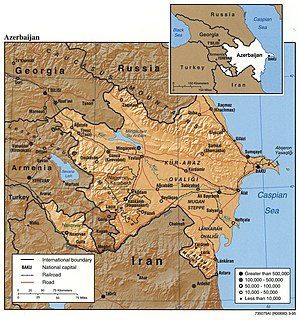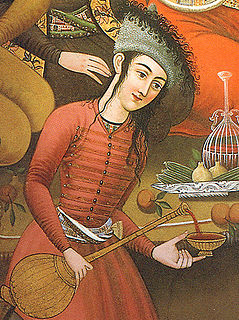 W
WThe Albanian wine is produced in several regions throughout Albania within the Mediterranean Basin. The country has one of the oldest wine making traditions, dating back to the ice and Bronze Age whereas Ancient Illyrians inhabited the country's territory some 3,000 years ago. It belongs chronologically to the old world of wine producing countries.
 W
WAzerbaijani wine is produced in several regions throughout Azerbaijan. Prior to 20th century communist rule, Azerbaijan had a thriving wine industry that dated back to the second millennium BC. Azerbaijan's long history of wine production was rediscovered at archaeological digs of settlements in Kültəpə, Qarabağlar and Galajig where archaeologists discovered stone fermentation and storage vessels that included residue and grape seeds dating back to the second millennium BC. The Ancient Greeks were well aware of wine production in the area by at least the 7th century BC according to Herodotus. Later Strabo would comment in the 1st century BC about an Azerbaijani wine known as Albania. Arabic historians and geographers—most notably Abu'l-Fida, Al-Masudi, Ibn Hawqal and Al-Muqaddasi - described the extensive viticulture around Ganja and Barda that was taking place even after Islamic conquest of the area.
 W
WWhile Brazil has a relatively large number of vineyards, a large part of them produce table grapes, and only some produce Brazilian wine. As much of Brazil is close to the equator, most of the country unsuitable for viticulture due to heat and humidity. Most of the wine production of Brazil is concentrated in the south of the country, away from the equator, in the state of Rio Grande do Sul, around 29th parallel south, which is close to Uruguay and Argentina. In that area, many of the vineyards take advantage of cooler mesoclimates at higher elevations, to a large extent in Serra Gaúcha region.
 W
WWinemaking has a long tradition in Egypt dating back to the 3rd millennium BC. The modern wine industry is relatively small scale but there have been significant strides towards reviving the industry. In the late nineties the industry invited international expertise in a bid to improve the quality of Egyptian wine, which used to be known for its poor quality. In recent years Egyptian wines have received some recognition, having won several international awards. In 2013 Egypt produced 4,500 tonnes of wine, ranking 54th globally, ahead of Belgium and the United Kingdom.
 W
WThe Principality of Liechtenstein is a producer of wine. The country has a climate ideally suited for the cultivation of wine with mountain slopes facing southwest, calcareous soils and an average of 1,500 hours of sunshine a year. The hot dry wind during the summer months, known as the foehn aids cultivators by having a sweetening effect.
 W
WThis list of wine-producing regions catalogues significant growing regions where vineyards are planted. Wine grapes mostly grow between the 30th and the 50th degree of latitude, in both the Northern and Southern hemispheres. Grapes will sometimes grow beyond this range, thus minor amounts of wine are made in some rather unexpected places.
 W
WPalestinian wine has been in production since ancient times. In the region of Palestine, the use of wine was not only an important factor in religious ritual, but also a necessity for social interaction, general dietary consumption and medicinal purposes. During the Byzantine period, large-scale production led to international commerce in the commodity, and Palestinian wine was exported around the Mediterranean region. Production by Christians diminished with the Islamic conquest in the 7th century and was temporarily revived with the settlement of Frankish Christians under the Crusades in the 1100s. Jews continued to cultivate vineyards in the late 15th century into the Ottoman period. The first modern wineries were established by German settlers at Sarona in 1874/5 and by Jews at Rishon LeZion in 1882.
 W
WPersian wine, also called Mey and Badeh, is a cultural symbol and tradition in Iran (Persia), and has a significant presence in Persian mythology, Persian poetry and Persian miniatures.
 W
WSammarinese wine is wine from San Marino, which is home to a small but profitable wine industry. Being a small enclave within Italy, its wine industry is often overshadowed by its larger neighbour. The country produces a number of wines such as Brugneto and Tessano and Biancale and Roncale.
 W
WWine has been produced in the United States since the 1500s, with the first widespread production beginning in New Mexico in 1628. Today, wine production is undertaken in all fifty states, with California producing 89 percent of all US wine. The North American continent is home to several native species of grape, including Vitis labrusca, Vitis riparia, Vitis rotundifolia, and Vitis vulpina, but the wine-making industry is based almost entirely on the cultivation of the European Vitis vinifera, which was introduced by European settlers. With more than 1,100,000 acres (4,500 km2) under vine, the United States is the fourth-largest wine producing country in the world, after Italy, Spain, and France.